Supporting Language Growth in AAC Learners: Part 1
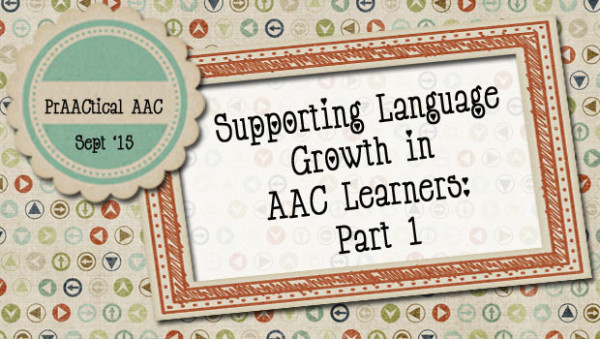
Here’s a sobering thought. Relatively few users of AAC use grammatically correct sentences when they communicate. There are lots reasons for that, but in this post, we focus on understanding the things that contribute to that problem. In Part 2, we’ll look at ways to address the issue.
Let’s reflect on the problem of why many AAC learners don’t communicate with complete, grammatically correct utterances.
When communication is time-consuming and difficult, it makes sense to put your effort to saying things that convey a lot of meaning and skip the rest. If you are trying to get your point across with as little effort as possible, content-heavy words, like agents, actions, and places, pack a punch. As clinicians, we are often so driven to understand the main points of what the learner is trying to convey that we promote that strategy. Here are two snippets to illustrate.
- Clinician: Look at you! I love the new T-shirt.
- Learner: Christmas.
- Clinician: Oh, you got it for Christmas?
- Learner: [nods yes]
- Learner: Camp.
- Clinician: You want to tell me about camp? That’s great! You’re going to have such a good time. When are you going?
- Learner: August.
- Clinician: What camp are you going to? Is it here in Florida?
- Learner: [shakes head no]
Are these successful interactions? It depends. In both cases, a well-intentioned therapist places the emphasis on meaning, and with good reason. She wants to get the learner’s point. And she does. From the standpoint of making a connection and establishing a general meaning, these are successful interactions. There are two things that contribute to that success. First, the learner chooses high-content words to provide a topical information. These low- frequency words – Christmas, camp, and August – give the clinician a starting point. Highly specific, low-frequency have taken a hit recently, as professionals and families have switched to a more core vocabulary focus. Both core words and high-content, low-frequency words play an important role, however, something we’ve written about before. In these conversations, the use of those content-rich words played an essential function: They established what the learner was talking about, albeit in a very general way.
The clinician used this information effectively to build a single word response into a conversation. Through the use of leading comments (e.g., I love the new T-shirt) and targeted questions (e.g., When are you going?), she uses vertical structuring to build a conversation with increasingly more details.
From the standpoint of meaning and connection, both of these are successful interactions.
So what’s the problem? Well, basically it’s this: Conversing in this way gives the learner practice in the skills they currently have, but isn’t sufficient to help them develop more advanced language skills.
Is it bad to have conversations like this, where single-word utterances with high-content vocabulary are vertically structured into a dialogue? Not necessarily. It depends on the purpose for the interaction and what we are targeting.
- Increased device use? Certainly!
- Building operational competence in finding and saying single words? Fine.
- Navigating between pages and screens? Terrific.
- Generalizing to new places and partners? That’ll work.
- Turn-taking? You betcha.
- Staying on topic? Absolutely?
There are lots of ways in which this approach is a good one. The problem is that if we continue to converse only in this way, we limit the learner’s language growth.
For the most part, exchanges like the ones above are good for conversation, but they aren’t necessarily therapy. The more we communicate in this way, the more the AAC learner will build the habit of having conversations with this sort of structure. For some, that’s an important step forward and we should continue to rely heavily on it for a period of time. For others, it can lead to some undesirable habits. Repeated use of vertical structuring like this promote passivity and can make learners overly dependent on their communication partners. It teaches AAC learners to wait until the right questions are asked, and to respond in the briefest way possible. There’s no need to do more than that, right? If the partner doesn’t understand, she’ll ask more questions that can be answered with a single word or sentence fragment. It sets up an expectation for both parties about their roles. One asks questions, and the other answers them as concisely as possible. Repeat as needed and the expectation for our roles is established.
As we’ve said before, expectation is a powerful thing.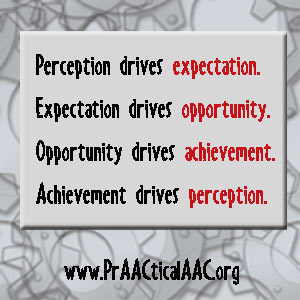
Heavy use of vertical structuring gives everyone practice in conversing in this style. The more practice we get with something, the more likely it is that we will keep doing it. That can be problematic because we can’t expect much language growth from interactions structured in this way. It’s conversation, not therapy.
To advance the learner’s language skills, we need to do things in a different way. In Part 2 of this series, we’ll explore some of those options. In the meantime, be an observer of the interactions you witness between people who use AAC and their communication partners. What is the learner gaining from that interaction? What are the next steps in promoting language growth? Stay tuned for more musings on this subject and feel free to share your own.
Filed under: PrAACtical Thinking
Tagged With: intervention, language therapy, vertical structure
This post was written by Carole Zangari


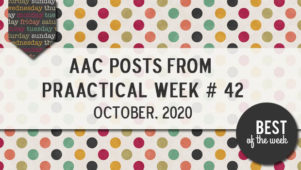
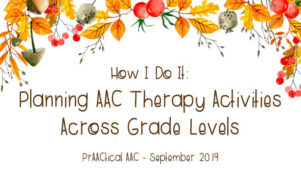
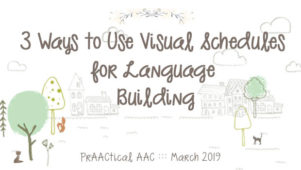
8 Comments
Great post very helpful. Thanks
Very true post, however very difficult to change the conversation style of everybody around the AAC user!! How do I ensure the bus driver, the changing personal care attendant, the friend, the majority of the people in the AAC users life so that they are challenging the user when they speak?! It’s these day in-day out conversations with the world that influence how the AAC user sees their role in life most.
Very difficult to control is all I’m saying.
Georgia, you raise a really good point for discussion. Obviously, every situation is different but here is my take on things. Conversation is one thing and therapy is another. Conversations with vertical scaffolding are fine for most things. Talking with family and friends, chatting with the bus driver. The point of the conversation is to connect and share. However, we SLPs need to go beyond that in our therapy to provide specific instructional experiences that will help the learner further develop their language skills. There may be conversation in therapy, of course, but we ‘do’ it differently so that the focus is on skill development and that often means that the scaffolding will address issues in morphology, syntax, etc. Sorry if I was unclear in the post.
Carole, I agree. As SLPs we have to take the user one step further all the time. Using expanding utterances, continuing to model and rephrase and recast and all of those other things at the next step beyond are all what we need to be doing in therapy – and even teaching the teacher and parents to do at home as much as possible – to ensure that these kids keep moving forward.
Thanks for this comment, Susan. Nothing is as heart-breaking as seeing kids with TONS of potential stall in their language development and the simple sentence level. We can do a MUCH better job at this. #KeepMovingAAC
Love this post Carole! It’s a discussion we have all the time. Really looking forward to your ideas and suggestions in part 2. Thanks!
Such a balancing act we have between often being one of the few (sometimes only) partners who will have these functional conversations and being the person having to make the AAC user work harder to interact. One of my children is discounted daily by the people in her life except myself and now her family. Her only control right now is exercised by deciding whether she will participate in work activities or not. She usually doesn’t choose to respond to teacher/therapist demands, even when we think we’re being exciting and interesting! I believe it can be a very long process in helping someone get to the point that they trust these little 1-2 word conversations are heard and respected; enough that they are willing to work even harder for grammar and syntax. I’m challenged to explain to my 11 year old multi handicapped, severely physically disabled and blind child why she should work harder to communicate. One of my other multi handicapped children is just starting to appreciate the power of working to expand 3-4 word sentences after 7 years of therapy. It’s difficult to say the least and requires a lot of empathy and effort on our part to make these language lessons highly motivating!
This is a great discussion point! I’m so glad you opened it up! It’s interesting to consider the progression of teaching syntax-thinking through the stepping stones to even beginning the process and not lose the communication momentum.
Such good points, Vicki, and why skilled AAC interventionists are so important in this process. What makes sense for some learners is completely inappropriate for others. One size will never fit all AAC learners. Thanks for taking the time to share these musings. #BetterTogetherAAC